In this article, you’ll learn What is a Governor? Its Working, Parts, and Types of Governors are explained with pictures.
If you need this article in PDF form, you can download it at the end.
What is a Governor?
In a spark-ignition engine, the carburetor is responsible for delivering a correct mixture of air and petrol but in a compression ignition engine, the situation is different. The air sucked inside the cylinder depends upon the breathing characteristics of the cylinders and varies with the speed and operating temperature of the engines.
The fuel delivered is determined quite independently by the characteristics of the pump, which for a fixed control piston may show a rising characteristic with speed.
The problem of matching the characteristics of engine and pump is difficult, where it is necessary to provide for running at varying speeds on a definite acceleration position. Here a governor serves the purpose. It controls both maximum and idling speeds.
Read also: List of Car Engine Parts: Its Function (With Pictures)
Governor Serves The Following Purposes:
- It controls fuel delivery at all engine speeds and varying load conditions. The quantity of fuel for idling and maximum speed is controlled and correct fuel delivery is ensured for all conditions in between these two extremes.
- It ensures that adequate fuel is delivered to the engine when idling, to avoid stalling, and also to limit the maximum amount of fuel that can be supplied to the injectors to prevent excessive engine speed, but the accelerator pedal to piston the control rod for all other speeds.
In a gasoline engine, the governor is usually placed between the carburetor and the intake manifold. The Centrifugal governor is attached to the camshaft by a gear drive.
The movement of the flywheel attached to the pivot arms of centrifugal governors is used to control the flow of gasoline in the carburetor, thus controlling the engine speed.
Types of Governors
Following are the three different types of governors used in automobile vehicles:
- Mechanical or centrifugal governor.
- Pneumatic governor.
- Hydraulic governor.
Read Also: What is the function of a Crankshaft Position Sensor?
Mechanical or Centrifugal Governor
Mechanical governors are fitted to large engines on an extension of the pump camshaft.
Working of Mechanical Governor
When the engine starts, the weights take up a position to maintain a stable idling speed. As the accelerator pedal is depressed against the spring, the weight moves inwards, and since the weight is linked to the control rod, the fuel delivery is increased and hence the engine speed also increases.
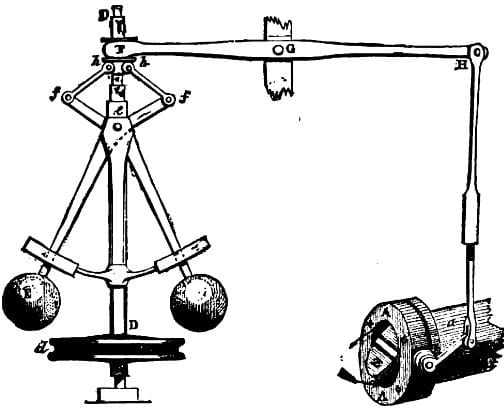
The increased engine speed causes the pump camshaft to rotate faster, which moves the weights outward against the action of control springs, so reducing the fuel delivery until the correct balance is arrived at for a particular engine operating condition.
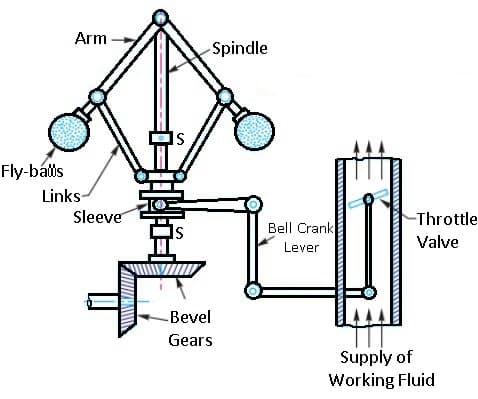
Thus, the accelerator does not increase delivery directly but delays the action of the governor. The relative position of governor-weight and control-rod positions when the engine is at idling and full-load positions.
Pneumatic Governor
Pneumatic governors are most successfully used in small and medium-sized engines. They are sensitive to variations in torque loading and ensure stable idling control. As with pneumatic induction pipe control, the air supply at light loads is throttle by a butterfly valve placed in a choke.
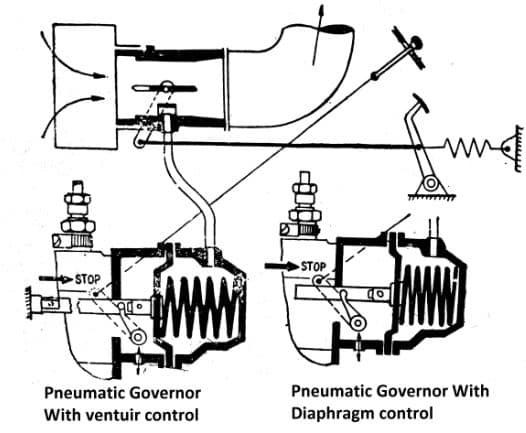
This valve is directly operated by the accelerator pedal. The throttle unit is placed between the air cleaner and the entry to the inlet manifold. Which results in reduced air pressure at the end of induction.
Injection then takes place into less dense air than with unrestricted induction, and the control thus becomes quantity rather than quality control. The fuel injection is controlled by the depression at the choke to a diaphragm chamber mounted on the end of the injection pump.
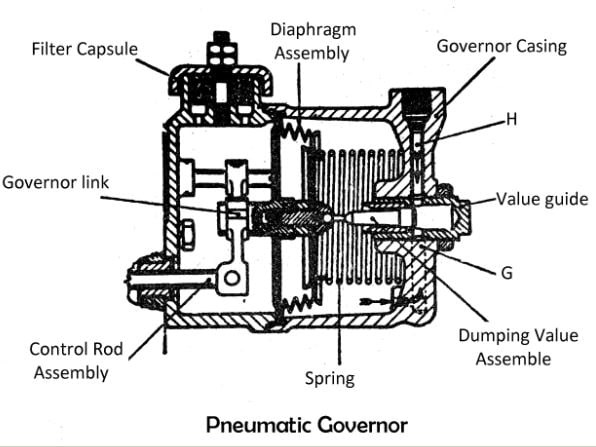
The diaphragm plate is mounted on the end of the control rack of the pump. It is pushed to the full load position (to the right) by the main control spring. Again, the increased depression at the throttle arises when the accelerator pedal is released. It will pull the diaphragm and control rod to the left, thus reducing the fuel supply.
An auxiliary spring is also used to balance the height depression at idling speed. It is brought into action progressively by the action of a cam.
Hydraulic Governor
Hydraulic governors eliminate the high mechanical forces bearing loads and possible torsional vibrations in the drive. And, hence they are preferred over mechanical governors.
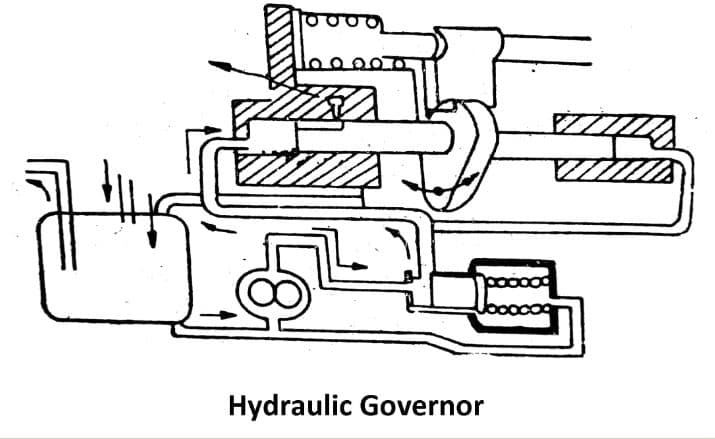
In a mechanical governor, the operative agent is the centrifugal force which governs the speed. In a hydraulic governor, it is the pressure difference across an orifice required to pass the oil flow from a positive oil pump driven by an engine.
The pressure difference varies as the square of the engine speed. And it is determined at equilibrium by the pressure of the driver’s foot on the accelerator pedal.
A hydraulic governor, like a mechanical governor, is an all-speed governor i.e., the governor is in control throughout the whole rack is operated by the governor and not directly by the accelerator to the supply to maintain the speed, no matter what the power requirements may be from moment to moment.
Conclusion
That is it, thanks for reading. If you have any questions on types of governors ask in the comment. If you found this article helpful share it with your friends.
Want free PDFs direct to your inbox? Then subscribe to our newsletter.
Download PDF of this article:
You might like to read more in our blog:
Well understood, is there a electric governor
Yes, ships use electric governors as well. It helps adjust engine speed from a no-load to a fully loaded condition.